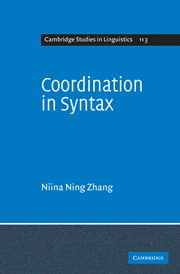Book contents
- Frontmatter
- Contents
- Acknowledgments
- Abbreviations
- 1 Introduction
- PART I NO SPECIAL SYNTACTIC CONFIGURATION
- PART II NO SPECIAL SYNTACTIC CATEGORY
- PART III NO SPECIAL SYNTACTIC CONSTRAINT
- 4 The Conjunct Constraint and the lexical properties of coordinators
- 5 The Element Constraint and the semantic relatedness of conjuncts
- 6 Three puzzles solved by rejecting the CSC
- 7 Relativized parallelism in syntactic complexes
- PART IV NO SPECIAL SYNTACTIC OPERATION
- 10 Conclusions
- References
- Index
4 - The Conjunct Constraint and the lexical properties of coordinators
from PART III - NO SPECIAL SYNTACTIC CONSTRAINT
Published online by Cambridge University Press: 04 August 2010
- Frontmatter
- Contents
- Acknowledgments
- Abbreviations
- 1 Introduction
- PART I NO SPECIAL SYNTACTIC CONFIGURATION
- PART II NO SPECIAL SYNTACTIC CATEGORY
- PART III NO SPECIAL SYNTACTIC CONSTRAINT
- 4 The Conjunct Constraint and the lexical properties of coordinators
- 5 The Element Constraint and the semantic relatedness of conjuncts
- 6 Three puzzles solved by rejecting the CSC
- 7 Relativized parallelism in syntactic complexes
- PART IV NO SPECIAL SYNTACTIC OPERATION
- 10 Conclusions
- References
- Index
Summary
Introduction
The CCi and CCe
The Coordinate Structure Constraint (CSC, Ross 1967: 89) states: “In a coordination structure, no conjunct may be moved, nor may any element contained in a conjunct be moved out of that conjunct.” As emphasized by Postal (1998: 95), the CSC was intended as a linguistic universal. However, from a minimalist perspective it is implausible that the theory of syntax has, in addition to operations such as Merge and Remerge, which apply in the computational system in its constructive sense, construction-specific stipulations such as the CSC, which give special instructions where the normal operations cannot apply. Nevertheless, it seems that the CSC has remained relatively immune to reduction to other more general principles. The goal of this chapter is to reduce the CSC to other general principles.
The CSC contains two parts (Grosu 1972; 1973). The first part is that no conjunct may be moved, and the second part is that no element may be extracted from conjuncts. Following Grosu (1972), we call the first part the Conjunct Constraint (CC), and the second part the Element Constraint (EC). This chapter discusses the CC, and the next discusses the EC. CC effects are shown in (4.1) and (4.2).
- Type
- Chapter
- Information
- Coordination in Syntax , pp. 79 - 123Publisher: Cambridge University PressPrint publication year: 2009



